Design and implementation of modern glass building facades

Introduction: In the realm of contemporary architecture, the use of glass in building facades has become increasingly prevalent. From towering skyscrapers to sleek office complexes and residential structures, glass facades not only offer aesthetic appeal but also embody innovation and functionality. The design and implementation of modern glass building facades represent a convergence of art, engineering, and sustainability principles. Let’s explore the evolution, techniques, and considerations in creating these iconic structures.
Evolution of Glass Facades: The history of glass in architecture dates back centuries, but it wasn’t until the late 19th and early 20th centuries that technological advancements allowed for its widespread use in building construction. The Crystal Palace in London, erected for the Great Exhibition of 1851, is often regarded as a pioneering example of large-scale glass architecture. Since then, architects and engineers have continuously pushed the boundaries of glass facade design, culminating in today’s cutting-edge structures.
Design Considerations: Modern glass facades are not merely about transparency but encompass a myriad of design considerations. Architects must balance aesthetics, structural integrity, energy efficiency, and occupant comfort. One of the primary goals is to maximize natural light penetration while minimizing solar heat gain, glare, and energy consumption. This requires careful selection of glass types, coatings, and shading systems tailored to the building’s orientation and climate.
Innovative Techniques: Advancements in glass technology and construction methods have revolutionized the design and implementation of modern facades. Some notable innovations include:
- Double-skin Facades: These consist of two layers of glass separated by an air gap, providing enhanced thermal insulation and acoustic performance. The cavity between the layers can also serve as a ventilation zone, improving indoor air quality and reducing reliance on mechanical systems.
- Dynamic Facades: Incorporating responsive elements such as electrochromic glass, smart tinting systems, and movable louvers, dynamic facades adapt to changing environmental conditions in real-time. They optimize daylighting, solar control, and privacy while adding a dynamic visual element to the building’s exterior.
- Photovoltaic Glass: Building-integrated photovoltaics (BIPV) allow glass facades to generate renewable energy while maintaining transparency. Thin-film solar cells embedded within glass panels harness sunlight to power the building’s electrical systems, contributing to sustainability goals without compromising design aesthetics.
- Parametric Design: Utilizing computational tools and algorithms, architects can create intricate facades with complex geometries and patterns. Parametric design enables precise control over form, performance, and material usage, facilitating the realization of iconic architectural visions.
Sustainability and Performance: In an era of increasing environmental awareness, sustainability is a paramount concern in building design. Glass facades play a crucial role in achieving energy efficiency and reducing carbon emissions. High-performance glazing systems, coupled with efficient HVAC and lighting systems, can significantly decrease energy consumption and operational costs. Additionally, strategies such as natural ventilation, daylight harvesting, and green roofs further enhance the sustainability credentials of glass-clad buildings.
Challenges and Future Directions:
Despite the numerous benefits and advancements in modern glass facades, several challenges persist. One of the primary concerns is the potential for excessive heat gain and glare, particularly in regions with intense sunlight. While innovative shading devices and glazing solutions can mitigate these issues to some extent, ongoing research is needed to develop more effective passive and active cooling strategies.
Furthermore, the lifecycle environmental impact of glass production and disposal remains a topic of debate. Addressing this requires a holistic approach that considers material sourcing, manufacturing processes, transportation, and end-of-life recycling or repurposing. Collaborative efforts among architects, engineers, manufacturers, and policymakers are essential to promote sustainable practices and minimize the ecological footprint of glass-clad buildings.
Looking ahead, the future of glass facades is likely to be shaped by advancements in materials science, digital fabrication, and artificial intelligence. Emerging technologies such as 3D printing, nanomaterials, and biophilic design principles offer new avenues for innovation in facade design and performance. Additionally, the integration of sensors, IoT devices, and machine learning algorithms enables intelligent facades that adapt to user preferences, weather conditions, and energy demands in real-time.
Moreover, as the demand for energy-efficient and resilient buildings grows, there is a growing interest in bio-inspired design principles and biomimicry. Drawing inspiration from nature’s inherent efficiency and adaptability, architects are exploring novel approaches to optimize building performance and enhance occupant well-being. Biomimetic facades may incorporate principles of self-shading, hierarchical structures, and adaptive materials to improve thermal comfort, daylighting, and air quality.
In conclusion, the design and implementation of modern glass building facades represent a dynamic intersection of art, science, and sustainability. While challenges persist, ongoing research and innovation promise to unlock new possibilities and elevate the performance and aesthetics of glass-clad structures. By embracing multidisciplinary collaboration and embracing emerging technologies, architects can continue to push the boundaries of design excellence and create iconic landmarks that inspire and endure for generations to come.





Leave A Comment